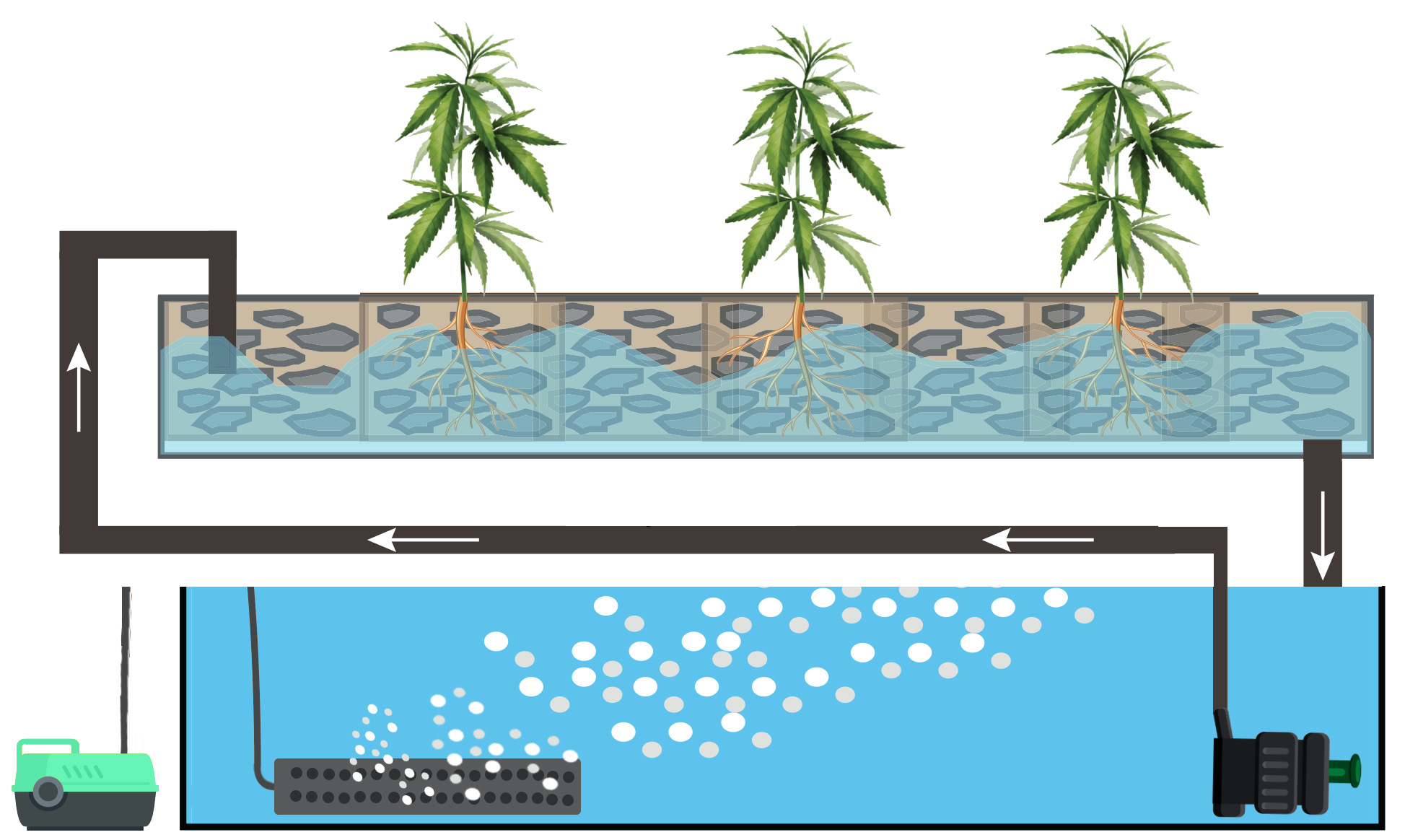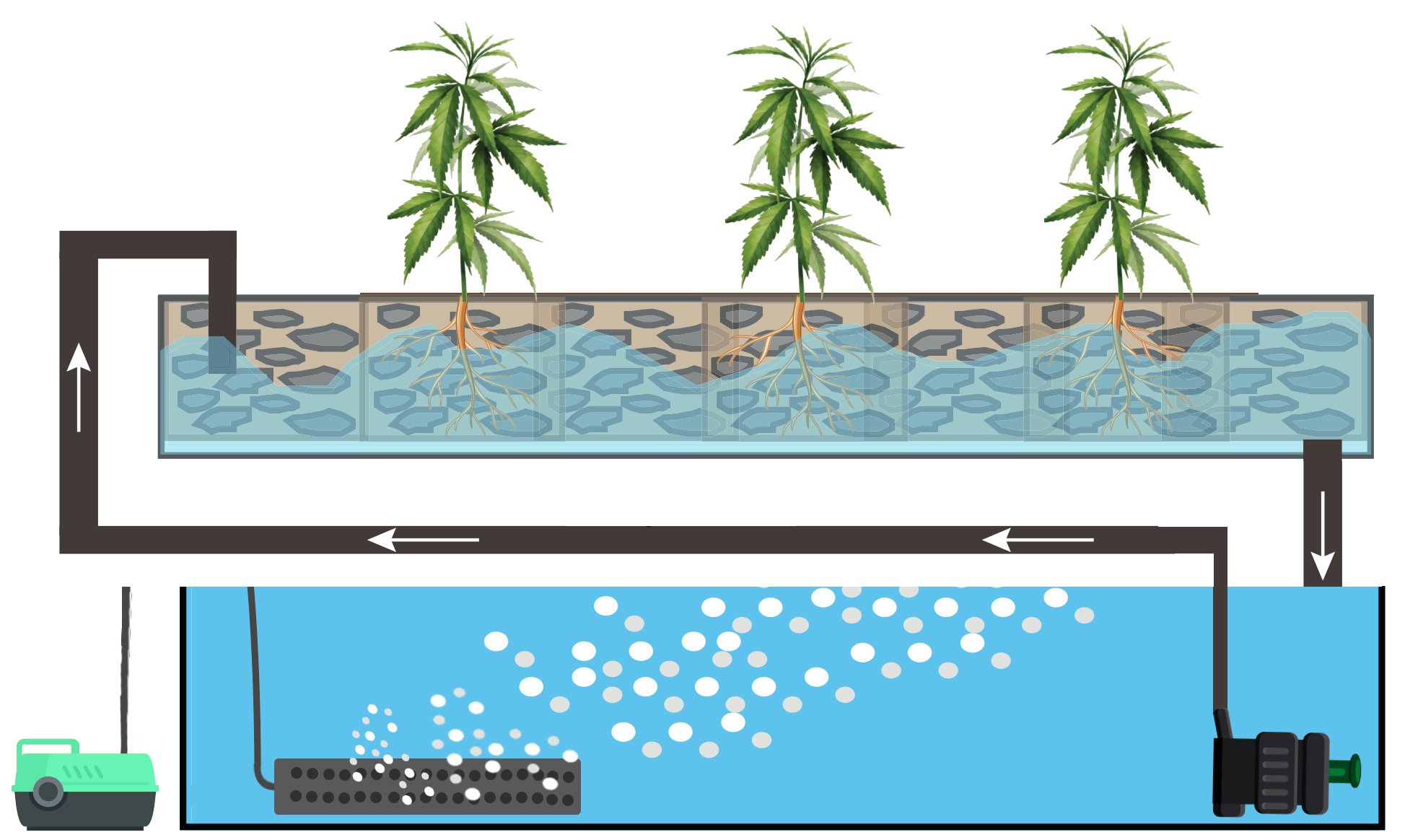What is an Ebb and Flow System?
Ebb and flow hydroponics, also known as flood and drain or flood table, is one of the most popular and versatile hydroponic systems in use. It is easy to understand, requires minimal technical knowledge and is suitable for both beginners and advanced hydroponic growers. This system is incredibly productive and can accommodate a variety of plants, of different sizes and in different sized pots, with great ease. Here are some of the benefits of using an ebb and flow system:
– Easy to understand and requires minimal technical knowledge
– Suitable for both beginners and advanced hydroponic growers
– Highly productive system
– Accommodates a variety of plants, of different sizes and in different sized pots with great ease
How does an Ebb and Flow system work?
An ebb and flow hydroponic system is an effective way of providing your plants with the nutrients they need, without the risk of root rot. The system works by flooding the roots of the plants with a nutrient solution, usually once or several times a day, and this is followed by a period of drying out (the ebb) which allows the roots to take on oxygen and avoid rotting. This system ensures that your plants get the right amount of nutrients, while also preventing them from becoming waterlogged.
Ebb and flow hydroponic systems are a great way to meet the nutrient requirements of your plants. This system works by flooding your plants’ roots with a nutrient-rich solution, then allowing them to dry out during the ebb period. The flooding period typically lasts a few inches of solution for just a short time, allowing your plants to feed from the bottom while their root mat remains exposed to the air. To make this system work, you need four basic components:
- Plant tray
- Reservoir with nutrients
- Submersible pump
- Timer (for reliability)
In general, ebb and flow systems involve a plant tray in which the plants are placed. Marijuana may be placed either in pots filled with a suitable growing medium, or by filling the tray itself with growing medium and placing the plants directly into that. A water pump with a timer periodically fills the tray with the nutrient solution, which is then allowed to drain back out into the reservoir. A simple overflow outlet prevents the tray from overfilling and avoids problems with overflowing and flooding your grow room.
Some of the disadvantages of the ebb and flow system are:
- As with NFT systems, an ebb and flow system is totally reliant on everything working properly. A simple pump malfunction or pipe blockage can result in a ruined crop in a very short time if left unchecked;
- If plants are placed in the tray without using pots then large amounts of growing medium are required, leading to more expense;
- Without good filters the ebb and flow system can be prone to blockages from pieces of growing media entering the system.
Suitable growing medium for Ebb and Flow
There is a wide range of suitable growing media for ebb and flow systems. If you are using individual pots you can use whatever your favorite hydroponic medium of choice is. Expanded clay pebbles, such as Hydroton, seem to be the most popular choice. These can be used either in pots or directly into the flood tray. Many growers employ both methods, using both pots and filling the plant tray, as this avoids any light getting to the root systems.

If planting directly into the tray it is a good idea to choose a medium with regular sized granules that are not too small, as this avoids the possibility of small pieces entering the pipes and clogging the system.
If you use Rockwool for cloning or raising seedlings then these just sit in the growing medium that you have chosen.
Some growers just use large Rockwool cubes placed directly into the tray without pots, and claim greater yields because of it. If you intend to do this you need to ensure that the plant tray is fitted with a cover that prevents light from getting to the roots.
Timing for a hydroponic Ebb and Flow system
Each individual flood should last around a half hour. Allow the flood tray to fill for 15 minutes and then to drain for 15 minutes. This is ideal for modern analog timers which are normally separated into 15 minute segments. Simply depress two segments at each time when you want a flood to occur. As with all areas of hydroponics, your timing will depend on the details of your set up. What you require is that your roots get plenty of oxygen between flows, but are not allowed to dry out too much so that it begins to adversely affect the plants.
How many times per day to flood your plants is open to debate. We have seen suggested timings given from one to six times per day. The following suggestions should help you to establish your own system depending on climate.
- Twice per day – in cooler, more humid environments or if using a slow draining medium such as Rockwool;
- Three times per day – in warmer environments or if using a fast draining medium such as expanded clay pellets;
- Four times per day – in very warm, dry, or outdoor environments with fast draining growing medium.
There will also be a difference between how many times per day you flood flowering or vegetative plants. During the veg period you will want to flood one more time per day than during the flowering period. This is to match the extra 6 hours of lighting that you are giving the plants during this time.
Whether you are vegging or flowering, you should allow your plants to ‘sleep’ and refrain from flooding during their night period. So if, for example, you have your plants vegging at 18 hours per day and want to flood three times per day, you will not be flooding the plants every 8 hours (00:00/8:00/16:00) but evenly across the plants’ day period (00:00/6:00/12:00). This allows for the plant to rest during the lights out period from 18:00 to 00:00.
Remember that you will need to adapt timings to suit your own circumstances. If you have a particularly slow pump or large tray, it will take longer to fill so the flood time will need to be longer. The same with how many times per day you flood your tray. Listen to your plants. If they exhibit signs of over or under watering, adjust your plan accordingly.
Building your own ebb and flow system is easily achievable by anybody with a rudimentary grasp of do it yourself skills. Once you understand the concept it is simply a question of arranging all the components in a way that works and fits in with your own requirements.
You will require:
- Reservoir with strong lid, a sturdy tote does the job;
- Plant tray (flood tray) that sits securely on top of the lid;
- Water pump (a garden pond pump is ideal);
- 2 fill and drain fittings, available from hydro suppliers or DIY/garden stores;
- Extension piece to create overflow;
- Length of ½” black tubing;
Once you have all the components together, you need to assemble them so that the water pump can fill the reservoir and then drain off afterwards. You also need an overflow system to prevent spillages.
- Make two holes in the centre of the base of the flood tray;
- Make corresponding holes in exactly the same position in the reservoir lid;
- Align the holes in the plant tray and reservoir lid and join them together by fitting both the fill and drain fittings to the holes;
- Attach one end of the black tubing to the water pump and the other end to one of the drain holes beneath the lid/flood tray assembly;
- Attach the overflow extension to the top of the other fill and drain fitting;
- Fill the reservoir with nutrient solution and position the water pump under the water by fitting the lid/flood tray assembly;
- Place your plants, in pots, in the flood tray;
- Set you timer accordingly.
When the pump runs the flood tray will fill with nutrient solution. The overflow pipe governs the depth of solution and will prevent the flood tray from overflowing.When the pump switches off, the nutrient solution flows back into the reservoir via the drain hole.

Some growers like to oxygenate their nutrient solution with the addition of an air pump and air stone.
Don’t forget to fit meshes/filters to the ends of all tubing to prevent your growing medium blocking up the system.
Rather than drain via the fill tube, some systems use separate fill and drain holes.
Ebb and flow hydroponic systems are an ideal choice for experienced growers. They are versatile, easy to set up, and require minimal maintenance when running properly. However, they do need to be monitored regularly to ensure that everything is running as it should be.
Ebb and flow systems are great for those looking for an intermediate level hydroponic system. They offer many advantages, such as:
– Versatility: you can grow a variety of crops in an ebb and flow system
– Easy setup: ebb and flow systems can be built quickly and cheaply
– Low maintenance: once the system is running properly, there is little to no ongoing maintenance
With careful monitoring and attention, you can enjoy the benefits of an ebb and flow hydroponic system without too much effort.

